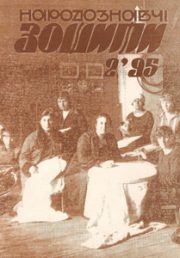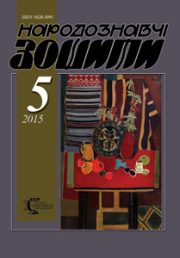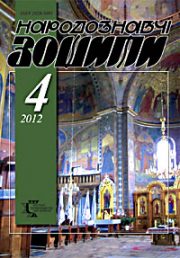The Ethnology Notebooks. 2020. № 1 (151), 233—244
UDK7.01: 792.01
DOI https://doi.org/10.15407/nz2020.01.233
THE STAGE DESIGN BY MYRON KYPRIIAN IN 60S OF THE TWENTIETH CENTURY
SHPAKOVYCH Oksana
ORCID ID: https://orcid.org/0000-0002-7710-3724
PhD student at the Lviv National Academy of Arts
38, Kubiiovycha Street, 79011, Lviv, Ukraine
Contacts: e-mail: ohirna@gmail.com
Abstract. Background. Studying the stage design of Lviv, one cannot ignore Myron Kypriian — an artist, whose creative achievements include about three hundred stage performances. He began his career at the Theatre of Opera and Ballet, and in fourteen years, he occupied a position of the chief designer in one of the European largest drama theaters — Maria Zankovetska Theater, where he works until present. The article presents the results of a study of Myron Kypriian’s scenography in the 1960s.
Problem Statement. A new source base has been introduced to a scientific circulation, namely theatrical reviews, local press reports of the time, as well as set design sketches and archival materials. We will try to analyze the background of 1960s during this period, a deep understanding of the artist’s creative theatrical heritage gives an opportunity to analyze the period of its formation and its innovative searches in the context of the development of Ukrainian and world scenography.
The purpose of the article is to analyze the stage design by Myron Kypriian in 1960—1969, to consider his influence on the development of the Ukrainian theater. Only after a few years of work in the M. Zankovetsky theatre, he has been raised to the level of the best scenographers in the Soviet Union.
The results of the research. The author of the article explored the sources; expanded and introduced into scientific circulation a new source base (theatrical reviews, reports of the Ukrainian and international press of the time, sketches of scenography, archival materials), on the basis of which the historiography of the study of the selected issues was analyzed and systematized, and the main subject of art set design by iconic theatrical productions created by M. Cyprian in the 1960s.
Conclusion. In his work, M. Cyprian combines the understanding of national form and European art, embodying, using the latest achievements of technology (slides, light effects and projections, films, photo fragments, mobile dynamic structures, the latest materials, etc.). This, in fact, determines the figurative and stylistic features of his work — a subtle rethinking of dramaturgy, conciseness, the ambiguity of a black box of a scene filled with only planes and individual details.
Keywords: artist, set designer, theater reformers, Ukrainian theater in the 1960s, «effective set design».
Received 4.02.2020
REFERENCES
Borovska, L. (1994). Myron Kypriian. Ukrainskyi teatr, 2, 28 [in Ukrainian].
Grigoriev, G. (1960, 9 april). Theater in a language of satire. Lvivska pravda (P. 4) [in Ukrainian].
Plaushevskaya, E. (1960, 24 january). Name. Lvivska pravda (P. 3) [in Ukrainian].
Maximenko, S. (2013). Myron Kypriian: «Theater is a nirvana between life and death…». Kino-teatr, 3, 12—13 [in Ukrainian].
Kovalchuk, O. (2006). Artists of the Ukrainian theater of the 1950s — 1980s: imaginative searches in a time conference. Narysy z istorii teatralnoho mystetstva Ukrainy XX ctolittia. Akad. Mystetstvo Ukrainy; In-T Probl. Suchas. Mystetstvo. Kyiv: Intertekhnolohiia (P. 695—786) [in Ukrainian].
Kovalenko, G. (1969, november-december). Palette of Myron Kypriian. Mystetstvo (P. 25—26) [in Ukrainian].
Matskevych, A. (1966, 6 march). Divine Comedy. Lvivska pravda (P. 4) [in Ukrainian].
Ryabokobylenko, S. (1983, 2 august). In the infinity of the scenic space of M. Kipriіan. Vilna Ukraina (P. 3) [in Ukrainian].
Fialko, V. (2012). Renewal of the stage vocabulary of the Ukrainian theater of the 60s — the first half of the 70s of the XX century (first part). Naukovyi Visnyk Kyivskoho Natsionalnoho Universytetu Teatru, Kino i Telebachennia im. I.K. Karpenka-Karoho (Issue 11, pp. 70—89) [in Ukrainian].
Solomon, M. (1969). Drama, warm smile. Kultura i zhyttia (P. 3) [in Ukrainian].
Boboshko, Yu. (1969, 23 march). The Law of Poetic Theater. Kultura i zhyttia (P. 3) [in Ukrainian].
Vallo, M. (1969, 23 may). An attempt at a philosophical play. Literaturna Ukraina, 41 (2635), 3 [in Ukrainian].
Kiselev, J. (1969, 5 june). Zankivchany. Kultura i zhyttia (P. 3) [in Ukrainian].
Kulik, O. (1980). Lviv Theater n. a. M. Zankovetska. Kyiv: Art [in Ukrainian].







